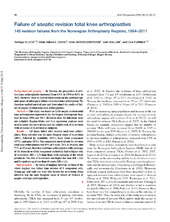| dc.contributor.author | Leta, Tesfaye Hordofa | en_US |
| dc.contributor.author | Lygre, Stein Håkon Låstad | en_US |
| dc.contributor.author | Skredderstuen, Arne Kr | en_US |
| dc.contributor.author | Hallan, Geir | en_US |
| dc.contributor.author | Furnes, Ove | en_US |
| dc.date.accessioned | 2015-08-05T13:04:23Z | |
| dc.date.available | 2015-08-05T13:04:23Z | |
| dc.date.issued | 2015-07-30 | |
| dc.identifier.issn | 1745-3674 | |
| dc.identifier.uri | https://hdl.handle.net/1956/10220 | |
| dc.description.abstract | Background and purpose — In Norway, the proportion of revision knee arthroplasties increased from 6.9% in 1994 to 8.5% in 2011. However, there is limited information on the epidemiology and causes of subsequent failure of revision knee arthroplasty. We therefore studied survival rate and determined the modes of failure of aseptic revision total knee arthroplasties. Method — This study was based on 1,016 aseptic revision total knee arthroplasties reported to the Norwegian Arthroplasty Register between 1994 and 2011. Revisions done for infections were not included. Kaplan-Meier and Cox regression analyses were used to assess the survival rate and the relative risk of re-revision with all causes of re-revision as endpoint. Results — 145 knees failed after revision total knee arthroplasty. Deep infection was the most frequent cause of re-revision (28%), followed by instability (26%), loose tibial component (17%), and pain (10%). The cumulative survival rate for revision total knee arthroplasties was 85% at 5 years, 78% at 10 years, and 71% at 15 years. Revision total knee arthroplasties with exchange of the femoral or tibial component exclusively had a higher risk of re-revision (RR = 1.7) than those with exchange of the whole prosthesis. The risk of re-revision was higher for men (RR = 2.0) and for patients aged less than 60 years (RR = 1.6). Interpretation — In terms of implant survival, revision of the whole implant was better than revision of 1 component only. Young age and male sex were risk factors for re-revision. Deep infection was the most frequent cause of failure of revision of aseptic total knee arthroplasties. | en_US |
| dc.language.iso | eng | eng |
| dc.publisher | Taylor & Francis | eng |
| dc.relation.ispartof | <a href="http://hdl.handle.net/1956/15574" target="blank">Revision Knee Arthroplasty in Norway 1994-2011. A register-based study with focus on implant survival, causes and risk of re-revision, pain relief, functional outcome, patient satisfaction, and health related quality of life</a> | |
| dc.rights | Attribution CC BY-NC-ND | eng |
| dc.rights.uri | http://creativecommons.org/licenses/by-nc-nd/3.0/ | eng |
| dc.title | Failure of aseptic revision total knee arthroplasties: 145 Revision failures from the Norwegian Arthroplasty Register, 1994-2011 | en_US |
| dc.type | Peer reviewed | |
| dc.type | Journal article | |
| dc.date.updated | 2015-08-05T13:00:31Z | |
| dc.description.version | publishedVersion | en_US |
| dc.rights.holder | Copyright Nordic Orthopaedic Federation | |
| dc.identifier.doi | https://doi.org/10.3109/17453674.2014.964097 | |
| dc.identifier.cristin | 1195311 | |
| dc.source.journal | Acta Orthopaedica | |
| dc.source.40 | 86 | |
| dc.source.14 | 1 | |
| dc.source.pagenumber | 48-57 | |

